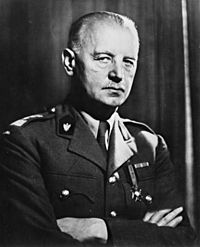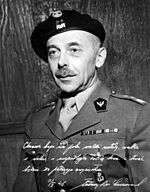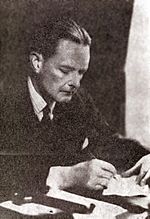Polish Institute and Sikorski Museum facts for kids

Polish Institute and Skorski Museum, main entrance
|
|
| Formation | 2 May 1945 |
|---|---|
| Type | Learned society |
| Registration no. | 312168 |
| Legal status | Registered charity |
| Purpose | Archival, educational, historical, and museological |
| Headquarters | 20 Prince's Gate, London, SW7 1PT |
| Services | Research and publications, lectures and events, heritage conservation, and exhibitions |
|
Chairman
|
Danuta Bildziuk |
|
Head of Archives
|
Andrzej Suchcitz |
| Website | www.pism.org.uk |
The Polish Institute and Sikorski Museum (Polish: Instytut Polski i Muzeum im. Gen. Sikorskiego), also known as the Sikorski Institute, is a top museum and archive in London. It is named after General Władysław Sikorski. The museum helps people learn about Poland during World War II and Poles living outside Poland.
It is a private organization run by experts from the Polish community in the UK. The museum is located at 20 Prince's Gate in West London. This beautiful old building is near Hyde Park. It is part of the same historic area as the nearby Polish Hearth Club. In 1988, the institute joined with another group called the Polish Underground Movement Study Trust.
Contents
A Place to Remember Polish History

The institute was created right after Second World War ended on May 2, 1945. Its main goal was to remember the Polish Underground State in Occupied Poland. It also wanted to preserve the history of the Polish government-in-exile and the Polish armed forces in the West. These groups played a big part in World War II.
At that time, Poland was taken over by a communist government. This made it dangerous for many Polish soldiers and civilians to go home. A large part of Poland was given to the Soviet Union. Many Polish people were killed or forced to leave their homes. The institute became a safe place to keep Polish history alive. It also published historical information that was banned in Poland.
What the Institute Does
The institute keeps many important historical items. These include stories from people who lived through the Warsaw Uprising in 1944. There are also documents, military flags, medals, uniforms, and artworks. The library has many books. You can also see personal items that belonged to Polish leaders, soldiers, and everyday people.
The institute has an amazing collection of over 5,000 photos and films. These were made digital in 2005–2006. Now, they can be used for exhibits and learning in Poland. Around 2006, the institute found 2,000 photos by Jan Markiewicz. These photos show the early Polish community in South London in the 1950s.
The Polish Underground Movement Study Trust

This group was started in 1948 by soldiers like General Tadeusz Bór-Komorowski. It was called the Polish Underground Movement (1939–1945) Study Trust. It joined with the Sikorski Institute in 1988. Even though it became part of the institute, it still does its own research and publishes books.
How the Institute is Run
The institute and Sikorski Museum has different parts:
- Archives: This is where old documents are kept.
- Museum: This includes photos, films, and sound recordings.
- Reference Library: A place to read and study.
- Administration: Handles the daily running of the institute.
- Publications: Creates books and other materials.
- Regimental Colours Fund: Helps preserve military flags.
A Council guides the institute. This Council chooses an Executive Committee. This committee manages the institute's daily work. The Chairman leads both the Council and the Executive Committee. People can become members in different ways, like being nominated or making a donation.
Since it started, the institute has had several chairmen:
- Prof. Stanisław Stroński PhD (1945–1951)
- Lt. Gen. Prof. Marian Kukiel PhD (1951-c.1965)
- Count Edward Raczyński PhD (c.1965–1976)
- Stanisław Leśniowski MSc (1977–1979)
- Capt. Ryszard Dembiński (1979–2004)
- Krzysztof Barbarski CEng (2004–2022)
- Krzysztof deBerg (2022 -2023 )
- Danuta Bildzuik (2023 - )
See also
- History of Poland (1939–45)
- Polish government in exile
- Poles in the United Kingdom
- Polish Library in Paris
- Polish Museum, Rapperswil
- Institute of National Remembrance
Images for kids
-
An exhibit about Poland's help in the Battle of Britain.
-
A report praising the Polish destroyer Piorun before the Bismarck sank.
-
Original writings by Polish poet Adam Mickiewicz.
-
The Władysław Anders room.
-
A bust of Władysław Anders.
-
A souvenir from the Battle of Monte Cassino.
-
A sculpture of Wojtek the soldier bear.
-
A plaque remembering the 50th anniversary of the Warsaw Uprising.
-
A bust of Jan Sobieski.


















